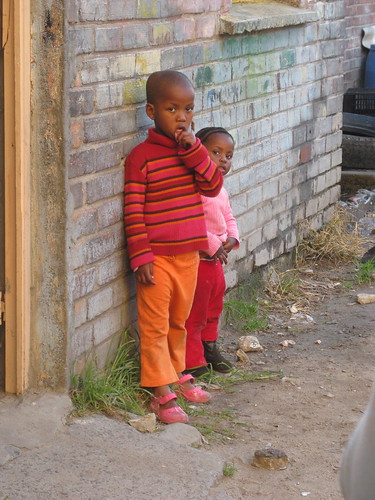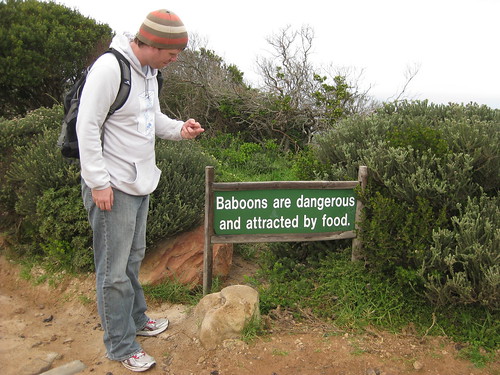As Ian was leaving the van he said, “I wonder how smart the baboons actually are.”
I was sitting securely belted in the van. Sharon, in the row behind me wanted out which would necessitate me also vacating the vehicle.
I didn’t want to get out.
Everyone else on the team was out, armed with their cameras, ready to capture the moment.
The moment, by the way, was a group of baboons entertaining tourists next to the mountain road we were taking to Cape Point.
I didn’t want to get out.
We’d passed to styles of signs that were pretty clear in their message. The first was simply an exclamation mark sitting atop the word “Baboons” in bold lettering.
The second was the more officious and daunting in its message, “Caution! Baboons are WILD animals…” That was enough to keep me in the car.
Behind me I could feel Sharon’s growing momentum toward exiting the vehicle. I got out to let her photograph the playful monkeys.
I decided to stay out as well, flashing on Nev Campbell answering the phone alone in the house in Scream.
It was as I was rolling up the window as a precaution that we learned “how smart the baboons actually are.”
Finding 1: Baboons can open car doors.
The Alpha Male, we’ll call him (Sprinkles), opened the driver’s door of the van. We’d later come to realize the more officious signs had encouraged passengers to close their windows and lock their doors.
Sprinkles didn’t stay in the driver’s seat long. In a flash, he was to the third row, picking up and tasting empty plastic bags for signs of food. He was on to something.
Finding 2: Baboons are not to be messed with.
Noble, in an attempt to embody his name, opened the rear driver’s-side door and attempted to shame Sprinkles out of the van. “No! No!” he yelled. “Out! Out!”
As it turns out, the status of Alpha Male is not so easily transferrable.
Finding 2.5: Baboons have large incisors.
(see annotation of Finding 2)
Finding 3: Baboons aren’t good with pockets.
As it turned out, I was the only member of the team who had packed snacks for our day trip to Cape Point. Sprinkles, equipped with an above-average proboscis detected my snacks and evacuated the vehicle through the rear driver’s-side door (all doors were open at this point. He left with my bookbag. Once clear of the van, he sat square in the middle of the road and attempted to find the food he’d smelled.
My oranges were in a side pocket intended for holding drinks. With no zippers, the oranges were easy access. They should have been, anyway. Sprinkles struggled with finding exactly how to get to the oranges. Perhaps from previous highway robbery, he knew of zippers, first trying to open the bad with his teeth and then with those beautiful opposable thumbs. Those damned thumbs.
In one pocket, he found the fruit leather I’d been hoping would last me to Kenya. Sprinkles ate it wrapper and all. Then, he found the Clif Bar. This one he opened before eating.
Finding 4: People will stop to watch a monkey.
While all of this was going on, traffic was appropriately stopped in both directions on the road and the other tourists who had already stopped to watch the monkeys had come over to photograph and video tape. “Who’s bag is that?” they all asked mid-laugh. I raised my hand and nodded.
Fruit leather and Clif Bar disposed of, Sprinkles returned to the oranges. Sitting in the road with approximately 20 onlookers recording the event to share with their friends and family when they returned to their international homes, he began to empty the contents of my pack into the road. My water bottle flew one way. My iPod flew the other. My journal was dropped on the pavement along with a book I’m reading on the teaching of reading in the content areas. Then the headphones and some stray papers. Then, a stuffed bear I travel with to pose for pictures with important landmarks.
Truly, life was complete.
Finding 5: A baboon will not leave a find until he’s finished it all.
Sprinkles eventually worked the first orange from the pocket and began to eat it. (They’re good peelers.) All the while, Noble had secured two granola bars from Sharon, broken them to pieces and tried to distract Sprinkles by throwing them a little farther down the road. At some point, one of the volleys proved successful and victory was ours until Sprinkles hurried back to his find and fished for the second orange.
Finding 5.5: Baboons are messy eaters.
Dripping baboon saliva and orange juice on my bag and belongings, it almost appeared Sprinkles was posing for the assembled onlookers as they chuckled and chortled at the tableau staged before them. I just wanted my stuff back. As Sprinkles finished off the last of the orange, it became clear he could sense the meal was over and he wandered off. Sharon, Jody and I ran up and shooed away a mother and her baby and another juvenile baboon who were intent on the spoils. Finding 2.5 isn’t quite as true about the little ones.
Finding 6: See image below.
Tag: twbc09
Oh, That’s Right!
 In South African educational parlance, teachers don’t teach “students,” they teach “learners.” I like that.
In South African educational parlance, teachers don’t teach “students,” they teach “learners.” I like that.
If the goal is lifelong learning, then we should start calling ourselves that as early as possible. I’d imagine it’s much easier to think of oneself as a learner in adulthood if you’re used to it from the time you enter school.
A difference exists between “student-centered” education and “learner-centered” education. One seems more all-inclusive, no?
It happened this week. We started Week 1 here in Cape Town with a plan for a week of student-centered workshops. It was to be a beautiful blend of pedagogy’s brightest shining all-stars (Traditional v. Progressive, learning in the Information Age, backward design, etc.) together with the shiniest and most collaborative of tools (digital storytelling, wikis, Google Apps, etc.). It was what was key for the students. In our heads.
But we had to become learners as well. Teaching pedagogy is all well and good in its place. Without a frame of reference for what it means to truly integrate ICT tools, though, the pedagogy doesn’t carry much weight.
We needed to learn what our learners wanted and needed – time to play.
Not unlike too many teachers in the States, teachers here need time to play with the tools at their disposal – tools their schools’ leaders are expecting them to come back ready to use.
We learned to give them what they wanted and what they needed.
The second half of the day Wednesday was dedicated to Word and PowerPoint – inserting pictures, transitions, text wrap, layout, design. Today’s sessions focused on Excel, Smart Boards, experimenting with PowerPoint and searching through flickr.
Yes, I realize pedagogy is important. We must be mindful of why we do what we do with whatever tools we use. Before that, we must experiment, we must be creative, we must fail and learn from that failure.
At the end of the PowerPoint session at the end of the day, our teachers still sat playing with pictures, text, transitions, research from online. They were constructing meaning from something they found interesting and saw held immediate value for their learners.
They were not so enthusiastic about backward design.
At the beginning of the week, Noble said in his welcome to the teachers that our team would be learning as much from the Capetonian teachers as they would be learning from us.
He was correct.
I Couldn’t Think of a Title
The original plan was to write once a day while here, but my gastrointestinal tract had other ideas. Now that I seem to be on the mend (had my first complete meal in three days tonight), I figured I should jump back in.
The thing that’s striking me here is how similar and dissimilar education in Cape Town seems to be compared with education back in the States, particularly Philadelphia. When talking to teachers about implementation of edtech, the obstacles they list the usual suspects:
- lack of resources
- resistant administration
- no time
- no training
- it’s one more thing
Sounds familiar, right?
Some subtle differences – The teachers we’re working with have an average of 40-50 students in each class. If they teach in schools that are lucky enough to have computer labs, those labs have only 25 stations. While many of them would like to work in the lab during their prep periods, the expectation is that they will be in the teacher break room. Burglary is a huge problem. At Liwa Primary School, where we’ve been working, the computer lab has bars on the windows, two barred gates on the door that are padlocked shut and a bank vault-style door to get in. I was tempted to consider this a bit over the top until I learned of a school with similar security that had its computers stolen when burglars blew a hole in the wall to get in. This is to say nothing of reports of many teachers that the Internet in their schools is not exactly reliable.
One teacher, Rachelle, who teaches G8 English and G9 Econ told me today that her school is currently without Internet access after thieves dug up and stole the wiring to sell the copper. When she called the service provider to come replace the cable, they refused because of how frequently they’d had to re-cable the area.
Here’s the thing, though, the thing that’s simply awesome. These 50 teachers, a few with no computer access at all in their schools yet, keep showing up each day for an entire week of their winter break without monetary compensation because they believe these tools and this connectivity can make a difference for their students.
Rachelle, who has no Internet access for her students, who told me 19 of her school’s 25 computers had been stolen, who has every reason to give up on edtech, was amazingly excited at the prospect of having her students collaborate with mine during their study of A Midsummer Night’s Dream. The school’s secretary has a laptop with an Internet connection, she told me, and she’d use that to help her students connect with the world.
I’ve Been to the Mountaintop
 Something lighter today. It’s 12:15 AM as I write this, and we’re to be leaving for the school at 7:15 AM. My body’s been struggling against a restful night’s sleep for the past two nights, so I’m hoping to wear it down tonight. Clearly, it will have no other choice than at least one complete REM cycle. Yes, this is the plan of a 7 year old. Today was beautiful. As the weather was sunny and the clouds continued to hold back, we took advantage and visited Table Mountain. We took the gondolas rather than making the 4-5 hour hike each way. Next time, I guess. The mountain was tremendous and different than the others I’ve visited in the last 6 months (San Juan, Grand Canyon, Sedona, Blue Mountain). It was pushed up from the sea millions of years ago but remained only an island until the water receded. Most amazing was standing at a precipice and watching the clouds from below fly up the side and overhead. Part of something. On our return trip, we were able to stop by the Pick ‘n’ Pay to purchase the little things. Washing my hair with shampoo tonight rather than lathering with a bar of soap felt indulgent. That was nothing compared to using proper toothpaste to replace the miniscule tube I’d squirreled away from the plane ride. The bulk of the day, however, was spent planning tomorrow’s workshop in detail and scoping out the rest of the week. It was the first time the 6 of us sat in the same room to ply our craft in a focused way. As expected, the dynamic took us a bit to figure out. It was like working as part of a beginning faculty once again. I like that feeling. The biggest challenge for me is holding true to the concept that it’s the ideas, the ways of thinking that can make the most impact here. In the end, if a teacher we work with here isn’t proficient in using PowerPoint, I won’t be worried so long as she has started to see her colleagues in a collaborative life or has begun to let inquiry drive her classroom. With so much to talk about and only a week with this group of educators, I’m reminded of the lure of direct instruction. Fitting the core of ICT tools into a week feels like designing a micro-world history class. If they could just sit in the room, listening rapt with attention as each of us took a turn relaying important information, think how much we could teach. How much would they learn? Tonight, I’m closing with a question. If you were to design a week-long course in ICT, what would be at the top of your list? What would be the first things cut? What would be your biggest focus? All right, I’m closing with three questions.
Something lighter today. It’s 12:15 AM as I write this, and we’re to be leaving for the school at 7:15 AM. My body’s been struggling against a restful night’s sleep for the past two nights, so I’m hoping to wear it down tonight. Clearly, it will have no other choice than at least one complete REM cycle. Yes, this is the plan of a 7 year old. Today was beautiful. As the weather was sunny and the clouds continued to hold back, we took advantage and visited Table Mountain. We took the gondolas rather than making the 4-5 hour hike each way. Next time, I guess. The mountain was tremendous and different than the others I’ve visited in the last 6 months (San Juan, Grand Canyon, Sedona, Blue Mountain). It was pushed up from the sea millions of years ago but remained only an island until the water receded. Most amazing was standing at a precipice and watching the clouds from below fly up the side and overhead. Part of something. On our return trip, we were able to stop by the Pick ‘n’ Pay to purchase the little things. Washing my hair with shampoo tonight rather than lathering with a bar of soap felt indulgent. That was nothing compared to using proper toothpaste to replace the miniscule tube I’d squirreled away from the plane ride. The bulk of the day, however, was spent planning tomorrow’s workshop in detail and scoping out the rest of the week. It was the first time the 6 of us sat in the same room to ply our craft in a focused way. As expected, the dynamic took us a bit to figure out. It was like working as part of a beginning faculty once again. I like that feeling. The biggest challenge for me is holding true to the concept that it’s the ideas, the ways of thinking that can make the most impact here. In the end, if a teacher we work with here isn’t proficient in using PowerPoint, I won’t be worried so long as she has started to see her colleagues in a collaborative life or has begun to let inquiry drive her classroom. With so much to talk about and only a week with this group of educators, I’m reminded of the lure of direct instruction. Fitting the core of ICT tools into a week feels like designing a micro-world history class. If they could just sit in the room, listening rapt with attention as each of us took a turn relaying important information, think how much we could teach. How much would they learn? Tonight, I’m closing with a question. If you were to design a week-long course in ICT, what would be at the top of your list? What would be the first things cut? What would be your biggest focus? All right, I’m closing with three questions.
Day 2: The Townships
 The goal for my writing whilst I’m here has to be to get it all down whilst I’m still to close to my experiences to have perspective.
The goal for my writing whilst I’m here has to be to get it all down whilst I’m still to close to my experiences to have perspective.
Our first full day began with a trip to the Liwa Primary School which is where we’ll be conducting the bulk of our workshops over the course of the next three weeks. Honestly, John got it best during tonight’s debriefing when he said conditions at the school were better than he’d expected. From our Skype planning chats and this morning’s cursory drive through the townships, I wasn’t entirely certain what to expect. Two padlocked, razor-wired gates later and we were in.
The tech capabilities within the school include a 25-station PC lab with a 3-gig monthly Internet cap and three Smart Boards.
Now, I enjoy my interactive white board, but I can’t say as I’d sacrifice any of SLA’s student laptops for it. Think of the netbooks the school could have purchased.
After the school and a planning meeting to go over Monday’s schedule, we headed into Cape Town proper for lunch at a Muslim restaurant.
Konaye, our guide for our township tour this afternoon, met us at the restaurant and arranged for a friend of his from the neighborhood to give us some history on that section of town. What I learned whilst waiting for our appetizers would fuel a world history class for at least a semester.
I’m still sorting it all out. I likely will be for quite some time.
From lunch, we loaded into a van for the township tour.
I need to pause for a moment. “Township,” until today, had painted a quaint idyllic picture in my head.
In Cape Town, the townships are where black Africans and colored Africans were relocated after the displacement of Apartheid.
One family on top of another, on top of another in buildings of scap wood or corrugated metal.
According to Konaye, the government of Cape Town plans to have properly constructed government subsidized housing for the 2.5 million families who need it by 2014. I shared his doubt in the achievement of that goal.
The question Noble posed to one 23-year-old man who was working on completing his diploma in IT was what had kept him in school rather than dropping out.
“Education is something no one can take away from me,” he responded.
Clearly, someone put this guy, the eldest of 7 children who lives in a 3-bedroom apartment with his siblings an mother and father, the value of an education.
With the amazingly high dropout rate and sheer number of students in need of an education here, I wonder how to help make a difference and help teachers here communicate that same value to their students.
